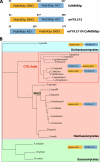Role of transcription factor CaNdt80p in cell separation, hyphal growth, and virulence in Candida albicans
- PMID: 20097739
- PMCID: PMC2863402
- DOI: 10.1128/EC.00325-09
Role of transcription factor CaNdt80p in cell separation, hyphal growth, and virulence in Candida albicans
Abstract
The NDT80/PhoG transcription factor family includes ScNdt80p, a key modulator of the progression of meiotic division in Saccharomyces cerevisiae. In Candida albicans, a member of this family, CaNdt80p, modulates azole sensitivity by controlling the expression of ergosterol biosynthesis genes. We previously demonstrated that CaNdt80p promoter targets, in addition to ERG genes, were significantly enriched in genes related to hyphal growth. Here, we report that CaNdt80p is indeed required for hyphal growth in response to different filament-inducing cues and for the proper expression of genes characterizing the filamentous transcriptional program. These include noteworthy genes encoding cell wall components, such as HWP1, ECE1, RBT4, and ALS3. We also show that CaNdt80p is essential for the completion of cell separation through the direct transcriptional regulation of genes encoding the chitinase Cht3p and the cell wall glucosidase Sun41p. Consistent with their hyphal defect, ndt80 mutants are avirulent in a mouse model of systemic candidiasis. Interestingly, based on functional-domain organization, CaNdt80p seems to be a unique regulator characterizing fungi from the CTG clade within the subphylum Saccharomycotina. Therefore, this study revealed a new role of the novel member of the fungal NDT80 transcription factor family as a regulator of cell separation, hyphal growth, and virulence.
Figures







Similar articles
-
Transcriptional control of hyphal morphogenesis in Candida albicans.FEMS Yeast Res. 2020 Feb 1;20(1):foaa005. doi: 10.1093/femsyr/foaa005. FEMS Yeast Res. 2020. PMID: 31981355 Free PMC article. Review.
-
The Flo8 transcription factor is essential for hyphal development and virulence in Candida albicans.Mol Biol Cell. 2006 Jan;17(1):295-307. doi: 10.1091/mbc.e05-06-0502. Epub 2005 Nov 2. Mol Biol Cell. 2006. PMID: 16267276 Free PMC article.
-
Genetic Analysis of NDT80 Family Transcription Factors in Candida albicans Using New CRISPR-Cas9 Approaches.mSphere. 2018 Nov 21;3(6):e00545-18. doi: 10.1128/mSphere.00545-18. mSphere. 2018. PMID: 30463924 Free PMC article.
-
The DNA-binding domain of CaNdt80p is required to activate CDR1 involved in drug resistance in Candida albicans.J Med Microbiol. 2006 Oct;55(Pt 10):1403-1411. doi: 10.1099/jmm.0.46650-0. J Med Microbiol. 2006. PMID: 17005790
-
Growth of Candida albicans hyphae.Nat Rev Microbiol. 2011 Aug 16;9(10):737-48. doi: 10.1038/nrmicro2636. Nat Rev Microbiol. 2011. PMID: 21844880 Review.
Cited by
-
Evolution of the complex transcription network controlling biofilm formation in Candida species.Elife. 2021 Apr 7;10:e64682. doi: 10.7554/eLife.64682. Elife. 2021. PMID: 33825680 Free PMC article.
-
Secretions from Serratia marcescens Inhibit the Growth and Biofilm Formation of Candida spp. and Cryptococcus neoformans.J Microbiol. 2023 Feb;61(2):221-232. doi: 10.1007/s12275-022-00007-3. Epub 2023 Feb 21. J Microbiol. 2023. PMID: 36809632
-
The Pathogenic Yeast Candida parapsilosis Forms Pseudohyphae through Different Signaling Pathways Depending on the Available Carbon Source.mSphere. 2022 Jun 29;7(3):e0002922. doi: 10.1128/msphere.00029-22. Epub 2022 May 9. mSphere. 2022. PMID: 35766504 Free PMC article.
-
Transcriptional control of hyphal morphogenesis in Candida albicans.FEMS Yeast Res. 2020 Feb 1;20(1):foaa005. doi: 10.1093/femsyr/foaa005. FEMS Yeast Res. 2020. PMID: 31981355 Free PMC article. Review.
-
Phenotypic and Proteomic Analysis of the Aspergillus fumigatus ΔPrtT, ΔXprG and ΔXprG/ΔPrtT Protease-Deficient Mutants.Front Microbiol. 2017 Dec 12;8:2490. doi: 10.3389/fmicb.2017.02490. eCollection 2017. Front Microbiol. 2017. PMID: 29312198 Free PMC article.
References
-
- Blackwell C., Russell C. L., Argimon S., Brown A. J., Brown J. D. 2003. Protein A-tagging for purification of native macromolecular complexes from Candida albicans. Yeast 20:1235–1241 - PubMed
-
- Butler G., Rasmussen M. D., Lin M. F., Santos M. A., Sakthikumar S., Munro C. A., Rheinbay E., Grabherr M., Forche A., Reedy J. L., Agrafioti I., Arnaud M. B., Bates S., Brown A. J., Brunke S., Costanzo M. C., Fitzpatrick D. A., de Groot P. W., Harris D., Hoyer L. L., Hube B., Klis F. M., Kodira C., Lennard N., Logue M. E., Martin R., Neiman A. M., Nikolaou E., Quail M. A., Quinn J., Santos M. C., Schmitzberger F. F., Sherlock G., Shah P., Silverstein K. A., Skrzypek M. S., Soll D., Staggs R., Stansfield I., Stumpf M. P., Sudbery P. E., Srikantha T., Zeng Q., Berman J., Berriman M., Heitman J., Gow N. A., Lorenz M. C., Birren B. W., Kellis M., Cuomo C. A. 2009. Evolution of pathogenicity and sexual reproduction in eight Candida genomes. Nature 459:657–662 - PMC - PubMed
-
- Cabib E., Roberts R., Bowers B. 1982. Synthesis of the yeast cell wall and its regulation. Annu. Rev. Biochem. 51:763–793 - PubMed
Publication types
MeSH terms
Substances
Grants and funding
LinkOut - more resources
Full Text Sources
Molecular Biology Databases

